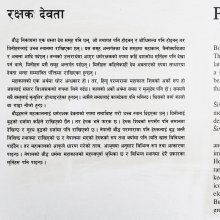Samuha, Samūha: 22 definitions
Introduction:
Samuha means something in Hinduism, Sanskrit, Jainism, Prakrit, Buddhism, Pali, the history of ancient India, Marathi, Hindi. If you want to know the exact meaning, history, etymology or English translation of this term then check out the descriptions on this page. Add your comment or reference to a book if you want to contribute to this summary article.
Images (photo gallery)
In Hinduism
Vyakarana (Sanskrit grammar)
Source: Wikisource: A dictionary of Sanskrit grammarSamūha (समूह).—Aggregate, group or collection; one of the prominent senses in which the tad. affixes अण् (aṇ) and others are prescribed. These affixes are called सामूहिक (sāmūhika); e.g. काकम् (kākam) (काकानां समूहः (kākānāṃ samūhaḥ)); similarly भैक्षम्, राजकम्, कैदार्यम्, जनता, मायूरम्, पाश्या, रथ्या (bhaikṣam, rājakam, kaidāryam, janatā, māyūram, pāśyā, rathyā) etc. cf. P. IV. 2.37 to 51.

Vyakarana (व्याकरण, vyākaraṇa) refers to Sanskrit grammar and represents one of the six additional sciences (vedanga) to be studied along with the Vedas. Vyakarana concerns itself with the rules of Sanskrit grammar and linguistic analysis in order to establish the correct context of words and sentences.
Purana and Itihasa (epic history)
Source: archive.org: Puranic EncyclopediaSamūha (समूह).—An eternal Viśvadeva (god concerned with offerings to the manes). (Anuśāsana Parva, Chapter 91, Verse 30).
Source: archive.org: Shiva Purana - English TranslationSamūha (समूह) refers to “masses (of women and their sons, etc.)” [?], according to the Śivapurāṇa 2.3.30 (“The Celebration of Pārvatī’s Return”).—Accordingly, as Brahmā narrated to Nārada: “On hearing that Pārvatī was returning, Menā and Himavat excessively delighted went ahead seated in a divine vehicle. [...] Women along with their sons and husbands (samūha—patiputravatīyoṣitsamūhaiḥ) held lamps in their hands. Brahmins were shouting mantras etc. in an auspicious voice. Various instruments were played. Conch shells were sounded. In the meantime Pārvatī reached the outskirts of the city. Entering the city she saw her parents again. [...]”.

The Purana (पुराण, purāṇas) refers to Sanskrit literature preserving ancient India’s vast cultural history, including historical legends, religious ceremonies, various arts and sciences. The eighteen mahapuranas total over 400,000 shlokas (metrical couplets) and date to at least several centuries BCE.
Shaktism (Shakta philosophy)
Source: Google Books: ManthanabhairavatantramSamūha (समूह) refers to a “mass” (e.g., ‘a mass of rays’), according to the Kularatnoddyota, one of the earliest Kubjikā Tantras.—Accordingly, “[...] You have a third form which is present (in the Transmission of) the Youth and ends with (that of) the Aged. [...] (This form of the goddess) breaks through the Wheels by means of (her) great mass of rays [i.e., mahāraśmi-samūha] that are to the side, above and below. Issuing forth from the Door of Brahmā, she has become one in the supreme, pure and unsupported Void. O Kubjeśī, you should be contemplated in this way residing in the Transmission of the Youth”.

Shakta (शाक्त, śākta) or Shaktism (śāktism) represents a tradition of Hinduism where the Goddess (Devi) is revered and worshipped. Shakta literature includes a range of scriptures, including various Agamas and Tantras, although its roots may be traced back to the Vedas.
In Jainism
General definition (in Jainism)
Source: The University of Sydney: A study of the Twelve Reflections1) Samūha (समूह) refers to a “collection (of objects)”, according to the 11th century Jñānārṇava, a treatise on Jain Yoga in roughly 2200 Sanskrit verses composed by Śubhacandra.—Accordingly, “Fool, perceiving this multitude of objects [com.—padārtha-samūha—‘collection of objects’] that is continually transitory and you do not understand. This is a planet without any medicine”.
Synonyms: Jāta, Prasara, Saṃbhāra, Pracaya, Jāla, Paṭala.
2) Samūha (समूह) or Asthisamūha refers to an “assemblage (of bones)”, according to the Jñānārṇava.—Accordingly, “Where is the body, which is filled with blood, flesh and fat, has a skeleton of slender bones [com.—asthi-samūha—‘having an assemblage of bones’], is bound with tendons and is of bad odour, praised? Continually pouring forth putrid smells through [its] nine orifices, the human body is ever perishable [and] dependent on other [things]”.

Jainism is an Indian religion of Dharma whose doctrine revolves around harmlessness (ahimsa) towards every living being. The two major branches (Digambara and Svetambara) of Jainism stimulate self-control (or, shramana, ‘self-reliance’) and spiritual development through a path of peace for the soul to progess to the ultimate goal.
India history and geography
Source: Cologne Digital Sanskrit Dictionaries: Indian Epigraphical GlossarySamūha.—(EI 28; CII 4), an assembly; the assembly of a corporation. Note: samūha is defined in the “Indian epigraphical glossary” as it can be found on ancient inscriptions commonly written in Sanskrit, Prakrit or Dravidian languages.

The history of India traces the identification of countries, villages, towns and other regions of India, as well as mythology, zoology, royal dynasties, rulers, tribes, local festivities and traditions and regional languages. Ancient India enjoyed religious freedom and encourages the path of Dharma, a concept common to Buddhism, Hinduism, and Jainism.
Languages of India and abroad
Pali-English dictionary
Source: BuddhaSasana: Concise Pali-English Dictionarysamūha : (m.) multitude; a mass; aggregation.
Source: Sutta: The Pali Text Society's Pali-English DictionarySamūha, (fr. saṃ+vah, uh) multitude, mass, aggregation Nett 195; PvA. 49, 127, 157 (=gaṇa), 200 (id.). (Page 689)

Pali is the language of the Tipiṭaka, which is the sacred canon of Theravāda Buddhism and contains much of the Buddha’s speech. Closeley related to Sanskrit, both languages are used interchangeably between religions.
Marathi-English dictionary
Source: DDSA: The Molesworth Marathi and English Dictionarysamūha (समूह).—m S An assembly, collection, accumulation, aggregate generally; a multitude or number, or a mass or heap.
Source: DDSA: The Aryabhusan school dictionary, Marathi-Englishsamūha (समूह).—m An assembly. A collection.
Marathi is an Indo-European language having over 70 million native speakers people in (predominantly) Maharashtra India. Marathi, like many other Indo-Aryan languages, evolved from early forms of Prakrit, which itself is a subset of Sanskrit, one of the most ancient languages of the world.
Sanskrit dictionary
Source: DDSA: The practical Sanskrit-English dictionarySamūha (समूह).—
1) A multitude, collection, an assemblage, aggregate, number; जनसमूहः, विन्नसमूहः, पदसमूहः (janasamūhaḥ, vinnasamūhaḥ, padasamūhaḥ) &c.
2) A flock, troop.
Derivable forms: samūhaḥ (समूहः).
Source: Cologne Digital Sanskrit Dictionaries: Shabda-Sagara Sanskrit-English DictionarySamūha (समूह).—m.
(-haḥ) Assemblage, aggregate in general, heap, number, multitude, quantity, &c. E. sam together, ūh to reason, or vah to bear, ghañ aff.
Source: Cologne Digital Sanskrit Dictionaries: Benfey Sanskrit-English DictionarySamūha (समूह).—i. e. sam-ūh, or vah, + a, m. Assemblage, multitude, [Śākuntala, (ed. Böhtlingk.)] [distich] 31; [Vedāntasāra, (in my Chrestomathy.)] in
Samūha (समूह).—[masculine] heap, collection, multitude, aggregate, a whole or totality.
Source: Cologne Digital Sanskrit Dictionaries: Monier-Williams Sanskrit-English Dictionary1) Samūha (समूह):—[=sam-ūha] [from sam-ūh] m. (ifc. f(ā). ) a collection, assemblage, aggregate, heap, number, multitude, [Atharva-veda] etc. etc.
2) [v.s. ...] an association, corporation, community, [Manu-smṛti; Yājñavalkya] etc.
3) [v.s. ...] sum, totality, essence, [Mahābhārata]
4) [v.s. ...] Name of a divine being (?), [Mahābhārata xiii, 4355]
5) Samūhā (समूहा):—[=sam-ūhā] [from sam-ūha > sam-ūh] f. ([scilicet] vṛtti) a [particular] mode of subsistence, [Baudhāyana-dharma-śāstra]
Source: Cologne Digital Sanskrit Dictionaries: Yates Sanskrit-English DictionarySamūha (समूह):—(haḥ) 1. m. Assemblage; number; quantity.
Source: DDSA: Paia-sadda-mahannavo; a comprehensive Prakrit Hindi dictionary (S)Samūha (समूह) in the Sanskrit language is related to the Prakrit word: Samūha.
[Sanskrit to German]
Sanskrit, also spelled संस्कृतम् (saṃskṛtam), is an ancient language of India commonly seen as the grandmother of the Indo-European language family (even English!). Closely allied with Prakrit and Pali, Sanskrit is more exhaustive in both grammar and terms and has the most extensive collection of literature in the world, greatly surpassing its sister-languages Greek and Latin.
Hindi dictionary
Source: DDSA: A practical Hindi-English dictionarySamūha (समूह) [Also spelled samuh]:—(nm) a group; collection; aggregate, assemblage, multitude; community; ~[ta] en bloc, en masse; ~[na] aggregation, collection; ~[vācaka] indicative of community/aggregate; collective; •[saṃjñā] collective noun.
...
Prakrit-English dictionary
Source: DDSA: Paia-sadda-mahannavo; a comprehensive Prakrit Hindi dictionarySamūha (समूह) in the Prakrit language is related to the Sanskrit word: Samūha.
Prakrit is an ancient language closely associated with both Pali and Sanskrit. Jain literature is often composed in this language or sub-dialects, such as the Agamas and their commentaries which are written in Ardhamagadhi and Maharashtri Prakrit. The earliest extant texts can be dated to as early as the 4th century BCE although core portions might be older.
Kannada-English dictionary
Source: Alar: Kannada-English corpusSamūha (ಸಮೂಹ):—
1) [noun] a collection; an assemblage; a crowd.
2) [noun] things piled up; a heap of things.
Kannada is a Dravidian language (as opposed to the Indo-European language family) mainly spoken in the southwestern region of India.
Nepali dictionary
Source: unoes: Nepali-English DictionarySamūha (समूह):—n. 1. collection; aggregate; 2. multitude; mass; 3. flock; herd;
Nepali is the primary language of the Nepalese people counting almost 20 million native speakers. The country of Nepal is situated in the Himalaya mountain range to the north of India.
See also (Relevant definitions)
Starts with (+2): Samuha-gana, Samuha-gita, Samuha-nritya, Samuhagandha, Samuhaka, Samuhakarya, Samuhakaryya, Samuhaksharaka, Samuhalakshita, Samuham, Samuhamadhyama, Samuhana, Samuhanati, Samuhani, Samuhasanni, Samuhashila, Samuhat, Samuhata, Samuhatatta, Samuhati.
Ends with (+12): Ajnanasamuha, Asthisamuha, Balasamuha, Bhasamuha, Bhitri-samuha, Carmasamuha, Dayadasamuha, Diksamuha, Dravyasamuha, Dvipasamuha, Ekarthavachinnasutrasamuha, Jatisamuha, Jvalasamuha, Kamasamuha, Kitasamuha, Kriyasamuha, Mahavatasamuha, Matadatasamuha, Nimna-samajika-arthika-samuha, Padarthasamuha.
Full-text (+109): Samuhakarya, Shastrasamuha, Vanasamuha, Samuhika, Yaugavaratra, Potya, Samuham, Samuhaksharaka, Samuhagandha, Samuh, Samuhaka, Samuhani, Vaishaya, Carmina, Carmana, Saira, Samuhana, Vyapoha, Samuhin, Samoha.
Relevant text
Search found 36 books and stories containing Samuha, Sam-uha, Sam-ūha, Sam-ūhā, Samūha, Samūhā; (plurals include: Samuhas, uhas, ūhas, ūhās, Samūhas, Samūhās). You can also click to the full overview containing English textual excerpts. Below are direct links for the most relevant articles:
Garga Samhita (English) (by Danavir Goswami)
Verse 4.2.6 < [Chapter 2 - The Story of the Gopīs That Had Been Sages]
Verse 2.9.22 < [Chapter 9 - Brahmā’s Prayers]
Verse 3.7.15 < [Chapter 7 - The Holy Places of Śrī Girirāja]
Tattvartha Sutra (with commentary) (by Vijay K. Jain)
Verse 3.21 - The direction of the first of each pair of rivers < [Chapter 3 - The Lower World and the Middle World]
Verse 4.1 - The four kinds of celestial beings (deva) < [Chapter 4 - The Celestial Beings]
Sahitya-kaumudi by Baladeva Vidyabhushana (by Gaurapada Dāsa)
Text 4.85 < [Chapter 4 - First-rate Poetry]
Ishavasya Upanishad with Shankara Bhashya (Sitarama) (by S. Sitarama Sastri)
Vakyapadiya of Bhartrihari (by K. A. Subramania Iyer)
Verse 1.16-17 < [Book 1 - Brahma-kāṇḍa (or Āgama-samuccaya)]
Verse 3.8.48 < [Book 3 - Pada-kāṇḍa (8): Kriyā-samuddeśa (On Action)]
Verse 3.8.4 < [Book 3 - Pada-kāṇḍa (8): Kriyā-samuddeśa (On Action)]
Yajnavalkya-smriti (Vyavaharadhyaya)—Critical study (by Kalita Nabanita)
Chapter 4.3 - Special Adjudicatory Machinery < [Chapter 4 - The Political Aspect Reflected in the Vyavahārādhyāya]
Chapter 4.7 - Existence of the Autonomous Bodies or Groups < [Chapter 4 - The Political Aspect Reflected in the Vyavahārādhyāya]

